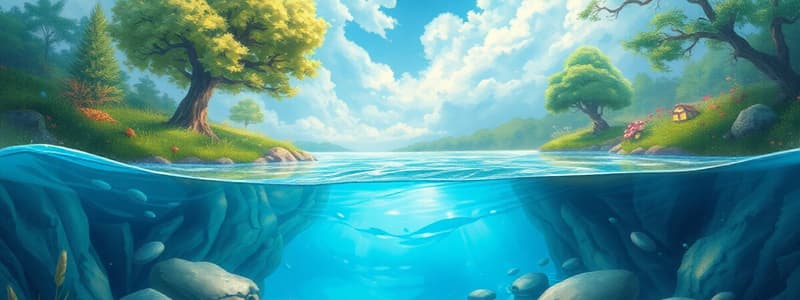Podcast
Questions and Answers
What effect does water evaporation have on the environment?
What effect does water evaporation have on the environment?
- It increases the temperature of the surrounding area.
- It cools the environment as energy is absorbed. (correct)
- It decreases humidity levels.
- It has no effect on the environment.
What occurs when water vapor exceeds a relative humidity of 100%?
What occurs when water vapor exceeds a relative humidity of 100%?
- Sublimation
- Evaporation
- Precipitation
- Condensation (correct)
What bonds hold the H and O atoms together in water?
What bonds hold the H and O atoms together in water?
- Van der Waals forces
- Ionic bonds
- Hydrogen bonds
- Covalent bonds (correct)
Which statement about the water cycle is true?
Which statement about the water cycle is true?
How does anthropogenic disturbance impact the water cycle?
How does anthropogenic disturbance impact the water cycle?
Which of the following is a consequence of water scarcity?
Which of the following is a consequence of water scarcity?
What happens to the environment when water vapor becomes liquid?
What happens to the environment when water vapor becomes liquid?
Which factor is least likely to impact natural water cycles?
Which factor is least likely to impact natural water cycles?
What is the primary source of freshwater for human use on Earth?
What is the primary source of freshwater for human use on Earth?
Which of the following statements is correct regarding hydrogen bonds in water?
Which of the following statements is correct regarding hydrogen bonds in water?
What characteristic of hydrogen bonds distinguishes them from covalent bonds?
What characteristic of hydrogen bonds distinguishes them from covalent bonds?
Which of the following describes the relationship between water and salt (NaCl) in a solution?
Which of the following describes the relationship between water and salt (NaCl) in a solution?
What role do vapor pressure and dew point temperature play in the atmosphere?
What role do vapor pressure and dew point temperature play in the atmosphere?
How does relative humidity change?
How does relative humidity change?
In which situation might water conflict arise among nations?
In which situation might water conflict arise among nations?
What controls the water vapor capacity of air?
What controls the water vapor capacity of air?
What defines the saturation vapor pressure in the context of the water cycle?
What defines the saturation vapor pressure in the context of the water cycle?
Which factor does NOT affect the dew point temperature?
Which factor does NOT affect the dew point temperature?
What can be concluded about human activities and water resources?
What can be concluded about human activities and water resources?
What is a major characteristic of a strong polar solvent like water?
What is a major characteristic of a strong polar solvent like water?
Which of the following concepts primarily studies the changes in population size over time?
Which of the following concepts primarily studies the changes in population size over time?
Which of the following factors is likely to affect human migration patterns?
Which of the following factors is likely to affect human migration patterns?
What is the primary purpose of population projection?
What is the primary purpose of population projection?
Which concept best describes the theoretical pattern of population change over time?
Which concept best describes the theoretical pattern of population change over time?
Which of the following would most likely NOT directly impact population growth rates?
Which of the following would most likely NOT directly impact population growth rates?
Flashcards
Hydrogen Bonds in Water
Hydrogen Bonds in Water
Hydrogen bonds occur between water molecules, being stronger than Van der Waals forces but weaker than covalent or ionic bonds.
Water as a Solvent
Water as a Solvent
Water's polarity allows it to dissolve many substances, particularly ionic compounds like salt (NaCl). The positive and negative ends of water molecules surround the ions, breaking apart the ionic bond.
Water Cycle
Water Cycle
The water cycle describes the continuous movement of water on, above, and below the surface of the Earth. This includes processes like evaporation, condensation, precipitation, and runoff.
Evaporation
Evaporation
Signup and view all the flashcards
Condensation
Condensation
Signup and view all the flashcards
Precipitation
Precipitation
Signup and view all the flashcards
Runoff
Runoff
Signup and view all the flashcards
Vapor Pressure
Vapor Pressure
Signup and view all the flashcards
Saturated Vapor
Saturated Vapor
Signup and view all the flashcards
Relative Humidity
Relative Humidity
Signup and view all the flashcards
Water Evaporation
Water Evaporation
Signup and view all the flashcards
Water Condensation
Water Condensation
Signup and view all the flashcards
Vertical Structure of the Atmosphere
Vertical Structure of the Atmosphere
Signup and view all the flashcards
Water Scarcity
Water Scarcity
Signup and view all the flashcards
Covalent Bonds in Water
Covalent Bonds in Water
Signup and view all the flashcards
Anthropogenic Impact on Water Cycle
Anthropogenic Impact on Water Cycle
Signup and view all the flashcards
Population Growth
Population Growth
Signup and view all the flashcards
Growth Curve
Growth Curve
Signup and view all the flashcards
Human Migration
Human Migration
Signup and view all the flashcards
Population Projection
Population Projection
Signup and view all the flashcards
Demography
Demography
Signup and view all the flashcards
Study Notes
Water Cycle Overview
- Water is crucial for ecosystems, communities, industries, agriculture, and commercial operations
- Water shortages, insufficient quantity or quality, severely impact the sustainability of life
- Water exists in three physical states: solid (ice), liquid (water), and gas (water vapor)
- These states connect the Earth's climate systems (air, clouds, ocean, lakes, vegetation, snowpack, glaciers)
Water Properties
- Water molecules are linked by hydrogen bonds
- These bonds are stronger than Van der Waals forces but weaker than covalent or ionic bonds
- Water acts as a strong polar solvent, dissolving ionic compounds like sodium chloride (NaCl)
- Na+ ions are attracted to the negative pole of water molecules
- Cl- ions are attracted to the positive pole of water molecules
- Water's ability to dissolve substances is vital for many biological and chemical processes
Global Water Distribution
- Earth's water is primarily saltwater (oceans, 96.5%)
- Freshwater accounts for a smaller portion (2.5%), including glaciers and ice caps (68.7%), groundwater (30.1%), surface water (lakes, rivers, etc., 20.9%), and other forms
- A diagram illustrates the distribution of water on Earth
- The different forms of freshwater are quantified. Specific amounts of water in various parts of the water cycle are shown (e.g., snowpack, ice sheets and glaciers, fresh lakes, rivers, soil moisture, renewable groundwater, non-renewable groundwater, surface ocean, deep ocean).
Water Cycle Processes
- Water cycles through the environment in various phases
- Processes include evaporation, condensation, precipitation, transpiration, runoff, infiltration and percolation
- These processes tie major parts of the Earth's climate system together (air, clouds, ocean, lakes, vegetation, snowpack, and glaciers)
- Diagrams illustrate the process and specific amounts.
- Details on precipitation over land and oceans, evaporation from ocean, lakes and rivers, runoff and percolation are presented
- Specific figures for each process (e.g., precipitation over the ocean [385,000 km³] and evaporation from the ocean [425,000 km³]) are included, with corresponding amounts of runoff [40,000 km³], and others.
Water and Temperature
- Water evaporation cools the environment, absorbing energy
- Water condensation heats the environment, releasing energy
- These changes in temperature relate to the movement of energy associated with water as it changes phase from liquid to vapor, solid to liquid and vapor to liquid
Atmosphere Moisture
- Water vapor pressure indicates the amount of water vapor in the atmosphere
- Relative humidity is the ratio of actual vapor pressure to saturation vapor pressure
- Temperature heavily affects water's capacity to hold vapor
- The relationship between the dew point temperature and vapor saturation in the air is illustrated via a diagram and is related to temperature and humidity.
Water Scarcity
- Water is a crucial resource, yet availability is uneven throughout the world. Conflicts may arise over water resources
- Different regions experience varying degrees of water scarcity (diagram illustrating scarcity areas), whether physical or economic
- Human use of water resources (agriculture, industry, urban needs) can lead to water scarcity in certain regions.
- Depletion and contamination of water sources are anthropogenic threats against water.
- Land conversion activities, climate change, and water use intensify water scarcity challenges. Water use aspects like thermal power, reservoir management, agriculture (rice, maize, wheat, perennials), livestock, and population are illustrated through diagrams, showing percentages or amounts of global water demand, and consumption. Specific examples of water conflicts are mentioned (e.g., Turkey-Iraq, Israel-neighbors, African countries).
- The potential for water to solve conflicts, such as the Darfur war, is highlighted.
Water Cycle Outline
- The lecture will cover preliminaries, the water cycle, and anthropogenic disturbances
- This overview will provide essential background information
Biogeochemical Cycles
- The lecture discussion includes the carbon, nitrogen, and water cycles
Studying That Suits You
Use AI to generate personalized quizzes and flashcards to suit your learning preferences.




